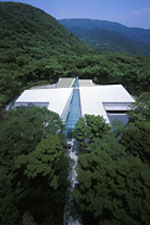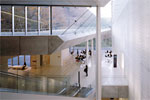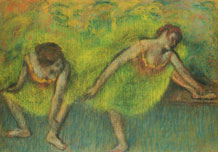 |
 |
 |
| A birds-eye view of the Pola Museum, surrounded by beech forest |

 |
 |
 |
| The Pola lobby, and the autumn mountainside beyond |
|
The remnants of a volcano that once rivaled its neighbor Fuji in size, Hakone is a lovely district of mountains, forests, lakes and hot springs that has long been a favorite retreat of the Tokyo elite. Only a bit over an hour from the metropolis by Romance Car super-express, Hakone's popularity as a short-jaunt destination has also made it a hot spot for museums of all sorts. One of the most eye-catching newcomers is the Pola Museum of Art, which opened in 2002 in an otherwise unspoiled beech forest on the slopes of Mt. Hakone.
Home to a collection of 9,500 works of both Japanese and Western art amassed by the late owner of the Pola cosmetics company, the museum is deservedly known for its excellent selection of paintings by the European masters of Impressionism, Post-Impressonism, the Ecole de Paris, and cubism. But the design of the museum itself is worthy of a visit in its own right. Boasting of the building's"symbiosis between Hakone's natural beauty and the works of art," the Pola's p.r. material takes pains to apprise visitors of the effort made to create a venue that harmonizes with its environment. To a great extent it succeeds, as museums go (although one can't help wondering why Pola was allowed to build it in the middle of a national park forest in the first place). All that pokes out of the forest floor is the glass atrium atop the building; the two main floors housing the galleries are buried below ground level.
On a late autumn day, crisp and clear, Hakone and the Pola were at their best. After a short stroll through the woods from the bus stop, a visitor's first glimpse of the entrance directed the eye straight through the all-glass lobby to the colors of the mountainside beyond. Inside, sunlight poured unobstructed through the atrium, bathing even the floors underground with natural light. There were worse places to spend a beautiful day indoors.
Which is not to say that the Pola is all form and no substance. Besides the very gratifying permanent collection, its special exhibits offer an intriguing diversity that seems inspired in equal parts by its founder's Eurocentric tastes and his line of business. Current shows, for example, include "Ballet in Art: Degas, Dali, Chagall" and "Combs from Around the World: Japan, Africa and Oceania" (both through March 18, 2007).
 |
 |
 |
 |
 |
left: Edgar Degas, Two Dancers Resting, from the “Ballet in Art” show
right: Tortoiseshell comb, late Edo period, from the “Combs from Around the World” exhibit
All images courtesy of the Pola Museum of Art |
|